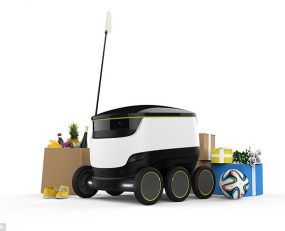
Consumer shopping habits are constantly changing with online and ‘top-up’ shopping becoming more prevalent. Logistics providers and retailers are noticing a trend towards more frequent demand for smaller numbers of items. This increasing demand is placing a significant strain on retailers and logistics providers to find delivery methods that will not significantly reduce margins.
Delivery robots are seen as a solution to this and are increasingly adopted within the logistics industry, enabling providers to tackle issues such as labour shortages and help ease the pressures from the demand for e-commerce and food delivery services within cities.
Many companies, including Amazon and UPS, have invested in and are currently trialling delivery robots. Many of the robots across the companies share features, they are autonomous, six-wheeled and use cameras, radars, sensors, and artificial intelligence (AI) to navigate the way towards their destinations. The robots use 3G technology to find their routes through the streets. Once the robot arrives, customers use an app to unlock the lid and retrieve the items.
Delivery robots offer attractive last-mile operations for logistics providers. They are a more environmentally friendly and a cost-efficient way to deliver goods. Starship technologies claim that the service in Milton Keynes has eliminated tens of thousands of unnecessary car journeys.
These services are gaining traction with some estimates that autonomous vehicles, including delivery robots, will account for 80% of last-mile deliveries by 2025. Consumers now expect goods to be delivered almost immediately and to some extent delivery robots will be able to ease these pressures. However, significant challenges remain. Missed or late deliveries are a common headache for both the consumer and the logistics provider. Even if consumers do choose a specific delivery time the robots themselves do not look particularly menacing and are vulnerable to theft.
Currently, the robots can climb curbs but are unable to climb stairs thus limiting their appeal to customers who live in multi-storey buildings. Many delivery robots only operate within a three to four-mile radius, travelling at 4 mph which is no faster than delivery by foot.
The robots are also limited by the number of goods it can deliver; some can only carry 10kg worth of goods. Although, this meets the demands of top-up shopping and small parcels it would not be viable for larger food deliveries which may require multiple trips or robots. Delivery robots may need to be capable of carrying larger packages to be an economically viable proposition in the long term. It will be interesting to see how Amazon’s ‘Scout’ progresses and whether or not it is capable of meeting these demands adequately.
Beyond the novelty of delivery robots, in reality how useful is this service? Many large cities have chaotic road systems and crowded pavements. If there were to be a small army of small capacity robots whizzing around busy streets it would cause multiple issues, both practical and legal. Already in some cities, such as San Francisco, delivery robots have been banned from operating on most of its sidewalks. Demonstrating an ability to overcome challenges will determine whether last-mile delivery robots move from an emerging technology to a more mass-market offering.
Source: Transport Intelligence, September 10, 2019
Author: Beth Poole